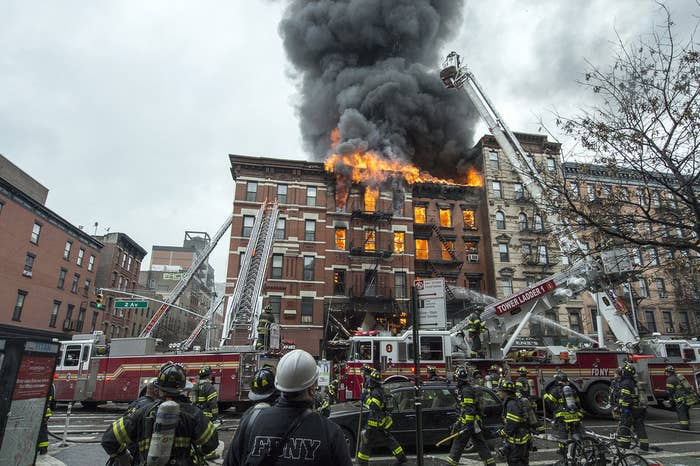
NEW YORK — The four buildings that were devastated by Thursday's explosion in downtown Manhattan had violated city regulations for decades, public records show. But the destruction also highlighted the lingering pitfalls of an aging stock of buildings that is ill-equipped to withstand any sort of significant trauma.
The explosion, which injured dozens and killed two, appears to have originated with a gas leak at 121 Second Avenue, near the corner with 7th Street. The Manhattan District Attorney and the New York Police Department are still investigating, but Mayor Bill de Blasio told reporters at a news conference that preliminary information suggests that the explosion occurred when a private contractor improperly accessed a gas pipe.
Records show that the Department of Buildings had not issued a permit for any kind of work in the building since last year. Lack of construction permits isn't unheard of in the East Village, a neighborhood where expensive apartments and trendy businesses occupy low-quality tenement buildings erected at the end of the 19th century.
"I was surprised when I heard about the explosion, but I shouldn't have been," Luc Sante, an essayist best known for Low Life, a sprawling history of the Lower East Side, told BuzzFeed News. "With the exception of brownstones, which were built as single-family dwellings for the well-to-do, most older buildings in New York have something deeply wrong with them. This could have happened anywhere in the East Village."
At the time of the explosion, the century-old structures at the corner of Second Avenue and 7th Street had a total of 37 open violations, at least five of which were considered "hazardous" by the Department of Buildings, records show.
In 1988, for example, the city's Environmental Control Board issued a violation against 123 Second Avenue warning that "failure to maintain public stairs from the 3rd to 5th floors" was causing stairs and floors to sag towards the center of the building. Twenty-six years later, the violation remained unresolved.
The buildings had also accumulated 53 tenant complaints since the late 1980s, many of them involving illegal construction and subdivisions. It was around that time that the then-blighted neighborhood began to rapidly gentrify, pushing many landlords to perform sometimes haphazard renovations on the rickety brick structures that line the streets in that part of Manhattan.
Sante — who as an aspiring poet lived in the neighborhood in the 1970s and '80s —witnessed the process first-hand.
"They did two main things," he said of the tenement landlords. "They would rejigger the plumbing so they could put in an actual bathroom — these buildings used to have the shower in the kitchen and the toilets in the hall — and they would gut the walls and divide the floors with sheetrock. It was purely cosmetic."
According to Sante, very few landlords took care to ensure that renovations were done properly. Most of the people who bought the nearly-empty tenement buildings did not intend to keep them very long, or even rent them out themselves.
"They would buy the building for $90,000, put in some sheetrock, and then flip it for two or three times the price," he said. "My old building on 12th Street had more than 30 owners in a single year."
Eventually, the tenements went through so many renovations that they began to look like a place where a young banker could aspire to live, but they remained inherently vulnerable to collapse.
"Buildings of that vintage are quite brittle," Donald Dusenberry, an engineer who specializes in blast-resistant structures, told National Geographic last year after an explosion destroyed a similar building in East Harlem. "Even a room-size natural gas explosion can trigger the collapse of an older masonry structure."
Beyond serving as a sobering reminder of the dangers implicit in aging buildings, last week's explosion also highlighted the fading history of one of New York's oldest neighborhoods.
At the time of the explosion, for example, the ground floor of 123 Second Avenue housed Pommes Frites — which offered no less than 28 varieties of ketchup and mayonnaise for an order of fries that cost $7.75. Sante recalled a time when the address was home to a Ukrainian store-front church called "Behold Jesus Come Quickly."
But the Ukrainian church itself had displaced older tenants. Second Avenue, Sante said, used to be known as the "Jewish Rialto" because it was lined with countless establishments dedicated to the Yiddish theatre.
And before that, the area served as the stage for the great gang wars of early 20th century New York, when gangsters like Humpty Jackson — who Sante described in Low Life as "a hunchback who always carried three guns, one in his pocket, one on his back below his hump, and a third concealed in the crown of his hat" — fought with people with names such as Johnny Spanish.
Earlier still, the neighborhood was known as "Little Deutschland." That designation died out after 1904, when a paddlewheel boat sank in the East River, drowning more than 1,000 parishioners of St. Mark's Lutheran Church and prompting most German residents to abandon the Lower East Side.
"Here you got a pattern where you have a neighborhood built for poor people, into which bohemians started moving because it was the cheapest place to live, and which then became unaffordable," Sante said. "But the reason it was cheap in the first place was that the housing stock was not very good. So now you have rich people living in substandard buildings."
When the city finishes cleaning up the rubble of the explosion, the buildings that will be erected at that corner will likely be much more sturdy and resilient. In doing so, they will also become an emblem of the new New York City: Clean, efficient, safe, and perhaps a little bland.
